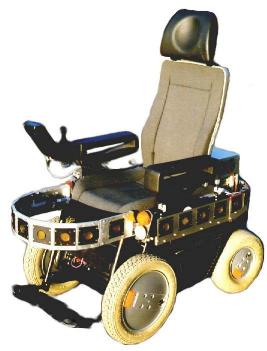
English
"Rolland" - Der Bremer Autonome Rollstuhl

Sicherheit in der Kognitiven Robotik und Verhaltensbasierte Navigation
Unter der Leitung von Professor Dr. Bernd Krieg-Brückner beschäftigt sich die Arbeitsgruppe "Kognitive Robotik" im Fachbereich Mathematik und Informatik an der Universität Bremen mit der Entwicklung eines intelligenten Transportmittels für behinderte und ältere Menschen - dem Bremer Autonomen Rollstuhl Rolland. Der mit Sensorik und Steuer-PC ausgestattete Elektrorollstuhl Meyra Genius 1.522 dient sowohl als wissenschaftliche Experimentierplattform im Rahmen des Schwerpunktprogramms "Raumkognition" der Deutschen Forschungsgemeinschaft (DFG) als auch als Demonstrator für den Einsatz formaler Methoden bei der Entwicklung eingebetteter Systeme.
Die Forschung im Bereich der Raumkognition konzentriert sich auf Fragen der Navigation. Dabei werden Erkenntnisse aus der Psychologie und der (Neuro-) Biologie berücksichtigt, es wird aber auch versucht, in diesen Bereichen noch offene Fragen durch die technische Umsetzung auf einem Roboter zu beantworten. Letzteres ist insbesondere für die kognitive Psychologie interessant, da das Vorwissen eines Roboter-"Probanden", im Gegensatz zu tierischen und menschlichen Versuchskandidaten, sehr leicht exakt definiert werden kann. Neben der theoretischen Beschäftigung mit den Grundlagen der Navigation werden robuste Techniken untersucht, die es dem Rollstuhl, aufbauend auf verschiedenen Grundverhalten wie Wandverfolgung oder Einbiegen in eine Tür, erlauben, auch komplexe Verhaltensweisen zu erlernen. Die entwickelten Navigationsverfahren basieren auf dem optischen Erkennen von Wegmarken (natürliche oder künstliche Orientierungshilfen): Mit einer Videokamera werden markante Objekte in der Umgebung (wieder-) erkannt.
Der Einsatz des Bremer Autonomen Rollstuhls als Anwendungsbeispiel für die Entwicklung sicherer Systeme mit Hilfe formaler Methoden läßt sich mit der besonderen Relevanz von Sicherheitsaspekten in der Rehabilitationsrobotik begründen. Im Gegensatz zur klassischen Industrierobotik leben Menschen in der unmittelbaren Umgebung und häufig auch in direkter Abhängigkeit von einem Rehabilitationsroboter wie Rolland. Daher gilt es, diese Systeme sowohl in bezug auf Kollisionsfreiheit als auch in bezug auf die Befolgung von Benutzeranweisungen sicher zu entwickeln. Mit Hilfe einer Bedrohungsanalyse wurden Sicherheitsanforderungen definiert. Aus dieser Spezifikation ist ein Sicherheitsmodul entwickelt worden, das in Teilen formal verifiziert wurde. Es bildet die Schnittstelle zwischen zu entwickelnden Anwendungen und dem Sicheren Rollstuhl.
Als erste Applikation wurde ein Fahrassistent implementiert, der die vom Benutzer per Joystick vorgegebene Geschwindigkeit je nach aktueller Hindernissituation anpaßt, so daß z.B. bei der Annäherung an ein Hindernis langsam abgebremst wird. Außerdem kann eine Unterstützung bei der Türdurchfahrt erfolgen, das automatische Wenden auf der Stelle ist ebenfalls bereits umgesetzt. Im nächsten Entwicklungsschritt wird die Funktionalität des Fahrassistenten unter anderem um die Möglichkeit der Spracheingabe erweitert.
Weitere Informationen finden Sie hier.
Veröffentlichungen
Autor: Dr. Thomas Röfer
| Zuletzt geändert am: 11. August 2006 |